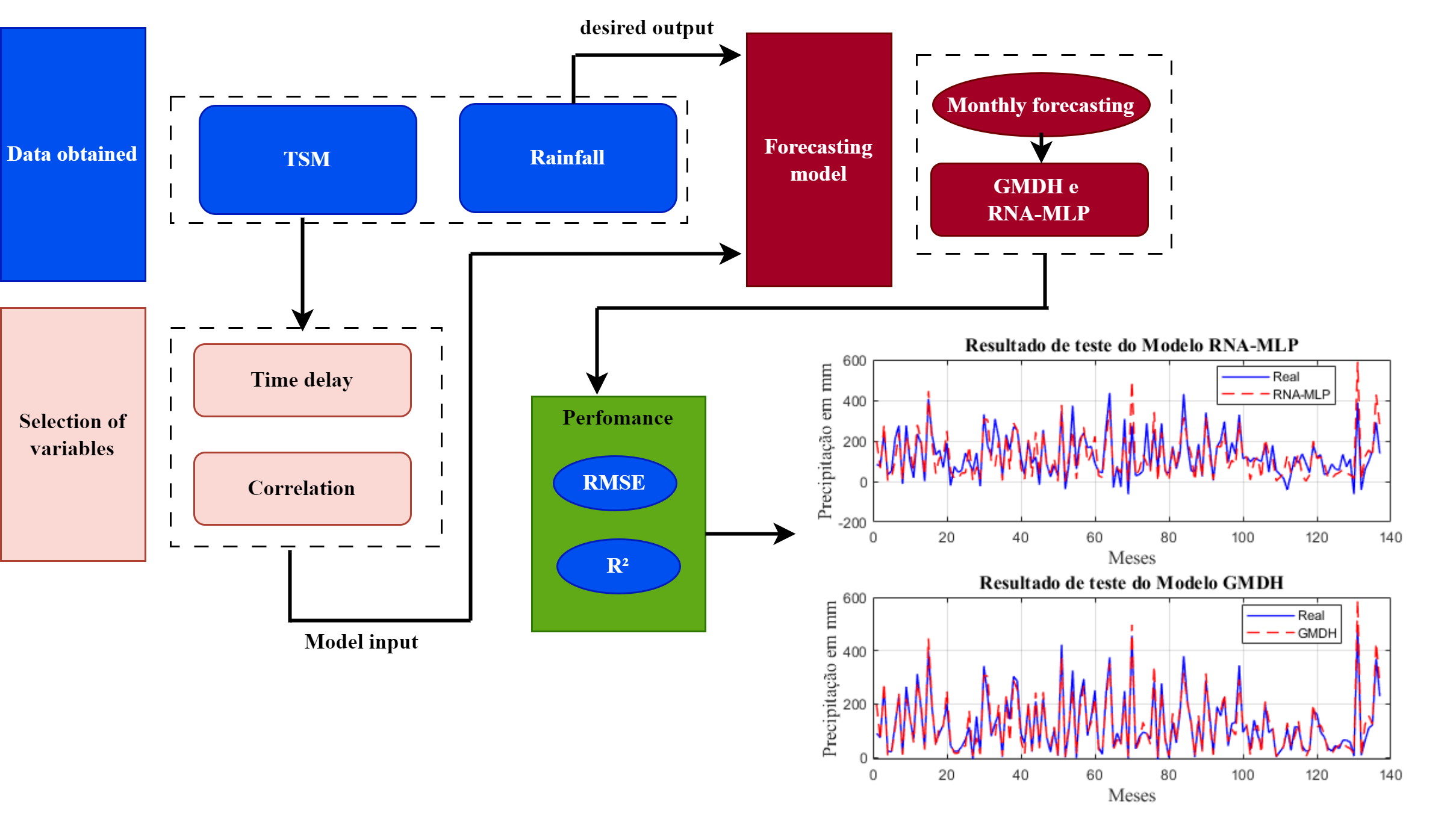A GMDH Approach for Forecast Monthly Rainfall in Southeast of Pará
Keywords:
Group Method of Data Handling, Sea Surface Temperature, Multilayer Neural Networks, Rainfall, ForecastAbstract
Modeling for rainfall forecasting is widely used in climate forecasting. A high volume of precipitation or scarcity brings serious problems for society. Thus, a methodology for monthly rainfall forecast is presented using Group Method of Data Handling (GMDH) and sea surface temperature (SST). The intelligent model gets the mean monthly SST, in predefined and temporally lagged areas, after a variable selection step. For model training, precipitation data from the Climate Prediction Center were used. The methodology was applied in a certain area of the municipality of Marabá, located in the southeastern region of the Pará state. The results obtained with GMDH overcame those got by using a conventional multilayer Artificial Neural those got by using a conventional multilayer Artificial Neural Network (RNA), reaching values for regression coefficient (R²) and root mean square error (RMSE) equal to 0.96363 and 30.8100 in the test stage, while the RNA-based model got 0.81712 and 68.2607, respectively. Results show the GMHD’s effectiveness for the monthly rainfall prediction, constituting an important tool for the planning and assistance to decision makers.
Downloads
References
G. Fisch, J. Marengo, and C. A. Nobre, “Uma revisão geral sobre o clima da amazônia,” Acta amazônica, vol. 28, pp. 101–101, 1998
M. N. L. Lopes, “Climatologia regional da precipitação no estado do Pará,” Revista Brasileira de Climatologia, vol. 12, no. 1, 2013.
E. B. Santos, P. S. Lucio, and C. M. S. Silva, “Precipitation regionalization of the brazilian amazon,” Atmospheric Science Letters, vol. 16,
no. 3, pp. 185–192, 2015.
M. B. Dias, N. R. Galina, and C. N. Alves, “Mapeamento da suscetibilidade a inundações em áreas urbanas: estudo de caso no município de marabá, sudeste do estado do pará, região norte do brasil,” Revista Ibero-Americana de Ciências Ambientais, vol. 12, no. 6, pp. 347–359, 2021.
K. Abhishek, A. Kumar, R. Ranjan, and S. Kumar, “A rainfall prediction model using artificial neural network,” in IEEE Control and System Graduate Research Colloquium, pp. 82–87, IEEE, 2012.
M. E. Akiner, “Long-term rainfall information forecast by utilizing constrained amount of observation through artificial neural network
approach,” Advances in Meteorology, vol. 2021, 2021.
D. Shukla, V. Rajvir, and M. S. Patel, “Rainfall prediction using neural network,” in 2018 International Conference on Circuits and Systems in Digital Enterprise Technology (ICCSDET), pp. 1–6, IEEE, 2018.
L. C. P. Velasco, R. P. Serquiña, M. S. A. A. Zamad, B. F. Juanico, and J. C. Lomocso, “Week-ahead rainfall forecasting using multilayer
perceptron neural network,” Procedia Computer Science, vol. 161, pp. 386–397, 2019.
A. Samad, V. Gautam, P. Jain, K. Sarkar, et al., “An approach for rainfall prediction using long short term memory neural network,” in
IEEE 5th International Conference on Computing Communication and Automation (ICCCA), pp. 190–195, IEEE, 2020.
R. K. Grace and B. Suganya, “Machine learning based rainfall prediction,” in 2020 6th International Conference on Advanced Computing and Communication Systems (ICACCS), pp. 227–229, IEEE, 2020.
H. A. Y. Ahmed and S. W. A. Mohamed, “Rainfall prediction using multiple linear regressions model,” in 2020 International Conference on Computer, Control, Electrical, and Electronics Engineering (ICCCEEE), pp. 1–5, IEEE, 2020.
Y. Dash, S. Mishra, and B. Panigrahi, “Rainfall prediction of a maritime state (kerala), india using slfn and elm techniques,” in 2017 International Conference on Intelligent Computing, Instrumentation and Control Technologies (ICICICT), pp. 1714–1718, IEEE, 2017.
I. Salehin, I. Talha, M. M. Hasan, et al., “An artificial intelligence based rainfall prediction using lstm and neural network,” in 2020 IEEE
International Women in Engineering (WIE) Conference on Electrical and Computer Engineering (WIECON-ECE), pp. 5–8, IEEE, 2020.
C. Basha, N. Bhavana, P. Bhavya, and V. Sowmya, “Rainfall prediction using machine learning & deep learning techniques,” in 2020 International Conference on Electronics and Sustainable Communication Systems (ICESC), pp. 92–97, IEEE, 2020.
P. Nastos, K. P. Moustris, I. K. Larissi, and A. G. Paliatsos, “Rain intensity forecast using artificial neural networks in athens, greece,”
Atmospheric Research, vol. 119, pp. 153–160, 2013.
Z. liang Wang and H. hua Sheng, “Rainfall prediction using generalized regression neural network: case study zhengzhou,” in 2010 International conference on computational and information sciences, pp. 1265–1268, IEEE, 2010.
M. A. Ayoub, A. Elhadi, D. Fatherlhman, et al., “A new correlation for accurate prediction of oil formation volume factor at the bubble point pressure using group method of data handling approach,” Journal of Petroleum Science and Engineering, vol. 208, p. 109410, 2022.
O. Dag and C. Yozgatligil, “Gmdh: An r package for short term forecasting via gmdh-type neural network algorithms.,” R J., vol. 8,
no. 1, p. 379, 2016.
M. Mrugalski, “An unscented kalman filter in designing dynamic gmdh neural networks for robust fault detection,” International Journal of Applied Mathematics and Computer Science, vol. 23, no. 1, pp. 157–169, 2013.
C. K. S. Ma, L. Chen, and A. Wang, “Application of group method of data handling to strean-way transition,” in 2009 International Joint Conference on Artificial Intelligence, pp. 301–304, IEEE, 2009.
A. G. Ivakhnenko, “The group method of data handling-a rival of the method of stochastic approximation,” Soviet Automatic Control, vol. 1, pp. 43–55, 1968.
P. Xie, M. Chen, S. Yang, et al., “A gauge-based analysis of daily precipitation over east asia,” Journal of Hydrometeorology, vol. 8, no. 3, pp. 607–626, 2007.
M.-H. Fun and M. T. Hagan, “Levenberg-marquardt training for modular networks,” in Proceedings of International Conference on Neural Networks (ICNN’96), vol. 1, pp. 468–473, IEEE, 1996.


